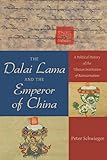The Dalai Lama and the Emperor of China : a political history of the Tibetan institution of reincarnation / Peter Schwieger.
Material type: TextPublication details: New York : Columbia University Press, (c)2014.Description: 1 online resource (ix, 342 pages) : illustrations, mapsContent type:
TextPublication details: New York : Columbia University Press, (c)2014.Description: 1 online resource (ix, 342 pages) : illustrations, mapsContent type: - text
- computer
- online resource
- 9780231538602
- 9781336021488
- DS786 .D353 2014
- COPYRIGHT NOT covered - Click this link to request copyright permission: https://lib.ciu.edu/copyright-request-form
| Item type | Current library | Collection | Call number | URL | Status | Date due | Barcode | |
|---|---|---|---|---|---|---|---|---|
 Online Book (LOGIN USING YOUR MY CIU LOGIN AND PASSWORD)
Online Book (LOGIN USING YOUR MY CIU LOGIN AND PASSWORD)
|
G. Allen Fleece Library ONLINE | Non-fiction | DS786 (Browse shelf(Opens below)) | Link to resource | Available | ocn905914446 |
Includes bibliographies and index.
Table of Contents; Preface; Introduction; 1. The Historical Development of the Trülku Position; 2. A Trülku as the Head of Society; 3. Struggle for Buddhist Government; 4. The Emperor Takes Control; 5. Buddhist Government Under the Imperial Umbrella; 6. Imperial Authority Over the Trülku Institution; 7. The Aftermath; Conclusion; Appendix 1: Tibetan Reincarnation Lines of Major Political Significance; Appendix 2: Qing Emperors and Qoshot Kings of Tibet; Abbreviations; Notes; Tibetan Orthographic Equivalents; Bibliography; Index.
A major new work in modern Tibetan history, this book follows the evolution of Tibetan Buddhism's trülku (reincarnation) tradition from the seventeenth to the nineteenth centuries, along with the Emperor of China's efforts to control its development. By illuminating the political aspects of the trülku institution, Schwieger shapes a broader history of the relationship between the Dalai Lama and the Emperor of China, as well as a richer understanding of the Qing Dynasty as an inner Asian empire, the modern fate of the Mongol empire, and current Sino-Tibetan relations. Unlike other pre-twentie.
COPYRIGHT NOT covered - Click this link to request copyright permission:
There are no comments on this title.
